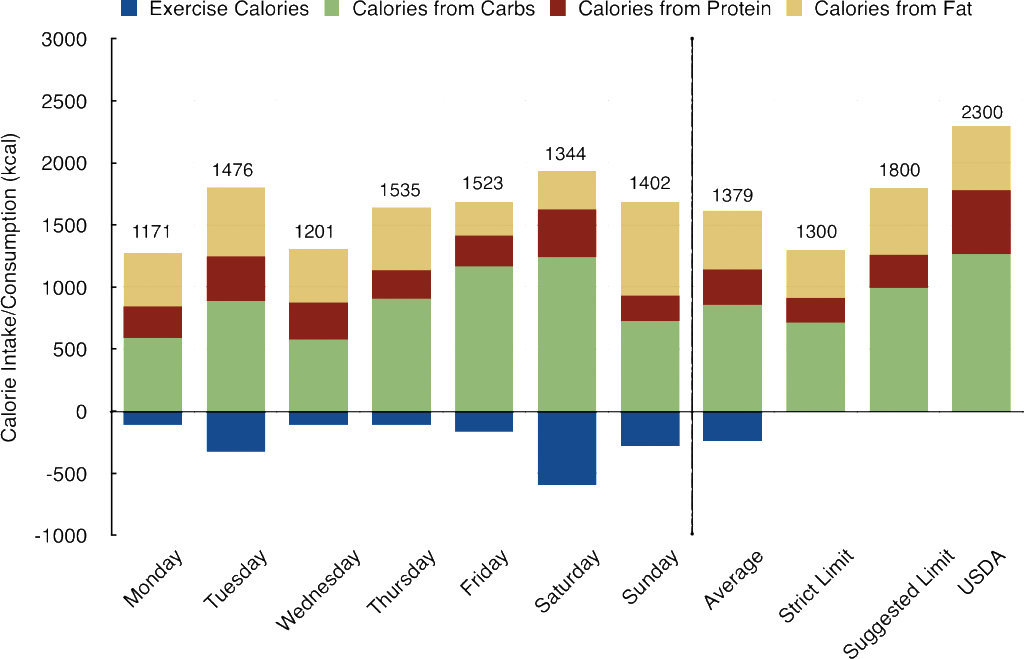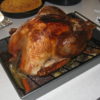
In the previous post we saw a brief history of the diets and the evolution of the dietary habits. The important questions answered were the ideal weight and the concept of calories. At the end what we saw was a comparative study of the various diets according to a US News article. From the discussion that preceded the ranking it became evident that there are two trends in dieting: restricting calories, or restricting certain foods, primarily carbohydrates. And we were left right there, hanging from a few more important questions. If the calorie intake is so crucial to the weight loss how can we see how much we need and you much we must take to maintain or lose weight? What diet is right for you? It is time to answer these questions. Please note however, that I am not a dietitian nor a doctor, I just know math and math usually never lie. Always before starting a diet or a serious dietary habit talk to your doctor.
We will do that by following as a subject myself. I am a 36 year old male, 1.85 m in height weighing about 193 lbs or 87.54 kgs. My ideal weight as it is calculated with the various models for someone with my physical statue it should be 78.54±3.74 kg, or according to the BMI value I should range between 63.3 – 85.6 kg. At my 87.54 kg I am considered overweight, and given the opportunity it is a good chance to get started on a diet. I need to lose about 10 kgs or 22 lbs which is not gonna happen anytime soon. I could however, start using a diet regime that will make me more fit and knock off some extra pounds. This will also give me the opportunity to test two restrictive diets; the Weight Watchers Points Plus and the calorie count. To follow me on this you can also calculate your ideal weight by using the calculator here or reading more about it in our previous post.
Ideal Weight Calculator:
Before we get started let me explain my reasoning of selecting these two particular diets. On one hand, we have all these diets that are based on food restrictions: Atkins, Paleo, Low Carb, low fat, Gluten free etc. These diets, although are somewhat backed up by science are not ideal for me. See, I am the kind of person who wants to eat a dessert, who enjoys the pasta and who loves to smother my bread with butter. Although when on diet typically none of these items are recommended, but calorie restriction and WWPP systems, allow you to deviate once in a while, and enjoy those pleasures. So I thought that what will be the point of trying a diet like gluten free, if I am not intolerant to gluten. Instead I followed the diet that allows me to eat what I crave most of the time, and allows me to exchange a whole meal for a cookie, or an hour of intense exercise with an ice-cream. Basically diet options that allow me to be me once in a while.
We know already enough from the previous post on the calorie restriction diet. Before we jump into the diet though we need to determine how much less calories a day we need to take in order to lose weight and determine how many we need to maintain our average weight. No! The answer is not zero. You probably notice that your body functions even when you are completely idle are still going on, the heart is beating, the muscles are alert and ready to go and most importantly the generation of heat to maintain the body temperature, that is known as thermogenesis. The heat can be measured to determine the amount of energy expended, and in most cases it is the majority of the energy consumed by body when idle. The total number energy used by body in rest, is called Basal Metabolic Rate (BMR) and it is an indicative of the energy someone needs in a day. BMR generally decreases with age and with the decrease in lean body mass (as may happen with aging). However, although increasing muscle mass increases BMR, the effect is not important to be considered a weight-loss method. Currently there are several prediction for the equations, but the most accurate is considered the one developed by Drs, Harris and Benedict, in 1919. The equation has been corrected several times due to improvement in instrumentation and larger statistical samples, but the basic formula remains the same.

Again keep in mind that this is just the energy your body requires if you are in a comma, not your actual energy needs. To correct we apply the Harris-Benedict correction:
- Little to no exercise: Daily kilocalories needed = BMR x 1.2
- Light exercise: (1–3 days per week): Daily kilocalories needed = BMR x 1.375
- Moderate exercise (3–5 days per week): Daily kilocalories needed = BMR x 1.55
- Heavy exercise (6–7 days per week): Daily kilocalories needed = BMR x 1.725
- Very heavy exercise (twice per day, extra heavy workouts): Daily kilocalories needed = BMR x 1.9
So based on this we can now estimate the daily average need of my body, considering that I am sitting for most of the day and absolutely no exercise. So with my body specifications we get a BMR of 1937.34 kcal/day. Now assuming no exercise in my daily life I need daily about 2317 kcal/day. This is actually approximately what the government considers as the average calorie intake foe someone in my size and and my age (USDA Table I). You can also check out the complete USDA Dietary Guidelines for Americans 2010 as well. It contains a great number of tips and information on what consists a balanced diet. So in my case to if I reduce my net calorie intake by 1100 kcal/day I will be losing 0.8 kg (1.7 lbs) per week. And I am referring to net calorie intake because as we discussed in the previous post you can lose weight by reducing the intake and increasing the consumption. Now you can calculate if you want your BMR and your daily energy needs with the following calculator.
Basal Metabolic Rate:
Let’s now shift gears and talk about Weight Watchers (WW). WW is an american company that helped millions of people to lose weight. The base of WW is a restriction of diet based on points and a very forgiving diet regime. Each food item has a specific number of points assigned to it based on the nutritional value. Until sometime in the 2011 the points depended on the calories, fat and fiber content of the food product. However, they changed the point calculation to be based on the fat, carbs, protein and fiber exclusively. Further they assigned to most vegetables and fruits 0 points. The reason for that was to give an advantage to fruits over other snacks like potato chips and cookies. Without going into details into the calculation of the WW Points I will give an example: an apple vs a chocolate chip cookie. An apple has 65 calories vs the cookie that has 57 (a small) and in the WW old system both have 1 point. So if you want a snack what would you pick? Yes the cookie. If you said the apple that means you never need to diet. To counter that WW rolled out a new method of calculating the points that automatic all fruits and vegetables are 0 points. So now you have a choice that is not even. In certain cases 1 point is a lot of points. From the 0 points rule are excluded fruits and vegetables that are starchy like potatoes and fruits like Avocado that are rich in fat. These calculation are not disclosed by WW since they are proprietary but are described in their patent. There are also other empirical equations that can give you an estimate.
Similar to the BMR, WW calculates a maximum amount of points allowed everyday in order to lose weight. In the same manner as the WWPP that are allocated to each food item, WW uses a top secret proprietary formula that again I will not get in the process of discussing. However, as the BMR it also depended on the weight, age and height. For my specific information the allowed amount of points is 41. In addition to these points, the WW give you an extra number of points that you can use either in a single day, or add them to your daily points to get something extra if you fill hungry, or if you had little food high in points. A medium burger for example can rack up almost 20 points and by no means it can be considered a filling meal. These points are also depending on your age, height and weight. Basically if you use the WW points and the bonus points you will break even and you will just remain the same weight. So it is recommended not to use them all. Further as you could imagine each exercise gives you extra points every day. WW has smart phone apps and even regular calculators and slide rules to help you estimate the points that you use or consume each day.
My Experiment
In this showdown I tried to comply with both diets, and compare the results in terms of how much I could adhere to the diet and the restriction, the nutritional value, the final result that was obviously the same for both. To keep track of the calories and the WWPP I used to different apps. For the calories I used the app MyFitnessPal and for the WWPP the Weight Watchers Official app. MyFitnessPal is a very comprehensive app with great design and allows you to add pretty much any food and activity. It has a huge library with thousands of brand foods and allows you to add your own. Similarly WW has a large library with brand and generic food items and also a build in calculator to calculate the points based on the nutritional facts. Further it gives some handy tips on how to calculate amounts, pizza points and a alcoholic drinks guide. Both apps require membership and while MyFitnessPal is free WW requires a $18.50 monthly subscription.
Starting with the MyFitnessPal it will ask for your measurements (height and weight) and will calculate the calories that you need to take in order to lose weight at the rate that you prefer. It suggests the rate of 1 lb/week but I pulled it up to the maximum which was 2 lbs a week. This gave me a total of 1300 kcal/day net intake. As I mentioned WW gave me an allowance of 41 points a day, but in order to be fair to MyFitnessPal I also reduced it to 38 points something I also did with the WW Bonus points, that I reduced from 49 to 39. To compare these I used the USDA data for proper nutrition and weight loss. So acording to the guide “USDA Dietary Guidelines for Americans 2010” for a person of my size and age a typical daily intake has to be constitute by 91g protein, 271g carbohydrates, 65g fat and 31g of fiber. If we now use the simple calculations, explained in detail in the previous post, this will results in a total calorie intake of 2222 kcal which is surprisingly close to the 2371 the BMR calculator pointed out and even closer to the estimated 2300 kcal USDA suggests.
Now starting from day one I record everything I eat on daily base as precise as possible. In case there is an inaccuracy in terms of the amount I research it and correct it later. So the values that will be presented here are very close to reality. Further I log all the exercise and to be precise on that I also used another app called Pacer that tracks movement and calculates precisely the amount of calories burned. It talks to MyFitnessPal so the data are automatically inputed. I need however to manually add them to WW. Also to keep up with the proper allocation of the calorie source I separated the calories in calories from fat, carbs (including fiber) and protein. Let’s see the results starting with the calories:

The bar chart looks a bit complicated but it is easy to break it down. On the left of side of the black line I have the calorie intake while on the right side I have the weekly average and the comparison to the limit I set for myself, the suggested limit (MyFitnessPal suggestion) and the USDA suggested calorie intake. On the positive site of the graph we have the calories that I take from food on daily base broken down to the calories from fat, carbs and protein and are color coded. The calories at right side of the chart is broken down according to the ideal case as suggested by the USDA. With blue at the negative side it are the calories burned through exercise. Finally at the top of each bar is written the net calorie intake. As you remember the limit I set for my self it was 1300 kcal per day. Even with some intense exercise at certain days the goal was achieved only once. Overall as it can be seen easily by the average, my average was a little over the limit I set for myself. Let’s look at the WW now.

The graph layout is the same as the calorie one described above, with the difference that the points are not broken down to the protein or fat or carbs since this is not compatible with the WW diet scheme. I did, however, add the bonus points as the over-the-limit points the days that I exceeded the points. In this case this was much easier to achieve as only three days I wend over the limit but given the fact that I have extra points to spare the average is actually lower than the set limit I had, that was quite strict. It is interesting to compare the USDA data that were described before in terms of the WWPP. Given the breakdown on meats, grains, fruits and vegetables we can calculate the WWPP that is 46 points that is lower than the points required to maintain the same weight (49/7+41=48 points).
What is very interesting and I want to draw your attention are two days: Tuesday and Sunday. While I was doing this research it was the FIFA World Cup and on Tuesday was the semifinal and on Sunday the Final. Both were watched with friends, pizza and beer. As you can see although the calories were just over the limit for both days (1472 and 1402 kcal), it blow the cap of the WWPP with a whooping 50 and 59 Points respectively. This looks counterintuitive since you would expect that going over the limit only by 200 kcal it will not affect the WWPP that much. However, the logic behind WWPP is to push you to consume food that is generally accepted as healthy and less of the unhealthy. A slice of pizza and a beer have about 350 kcal while they have 9 WWPP.
On the contrary on Saturday I ate almost exclusively vegetables in salads and consumed plenty of fruits. The food calories were significantly over the limit (1800 kcal) while the points were 18, less than half of my daily allowance. I think this is also a definite proof that the WWPP pushes you for a healthier way of life. The calories on the other side are not.
So what if the calories consumed are not healthy? Won’t you loose weight if you are below the limit if you are not eating healthy veggies and fruits? No, you will lose weight. It is simple math explained in the previous post. They key however, is the fact that the vegetables and fruits are as we said energy less dense. Eating them keeps you full, and you are not getting hungry quickly. This key to every diet. Even in the calorie diet you can have plenty of these foods and that will help you stick to the plan. The day I had pizza, for example the calorie intake initially was below the limit but I was hungry in the afternoon. That led me to eat more, going over the limit. But let’s go now to the key question: did I lose any weight? The short answer was yes. Here is a diagram that shows my weight in lbs on a daily base and also shows the weight loss on the same base.
The diagram is presented in the same way as those before. The first part shows the week day-by-day and the second part shows the average weight loss, the estimation of the weight-loss based on the strict limit and the suggested limit. The last bar shows the reduction from the USDA if I follow the suggested limit. Although in the graph it shows that Thursday was the highest weight loss, you need to understand that the daily weight fluctuates significantly based on the exercise, the hydration level and the pooping cycle. What is however interesting is the direct comparison of the reduction in the calorie intake with the associated weight loss.
 The graph shows something astonishing! The actual weight loss and the weight loss estimated based on the difference in the calories is almost a perfect match! Although as a scientist I would be excited that the theory meets the experiment, I am the first to tell you that, that was a coincidence. Yes. That is just happening randomly here. But it is interesting to see that the weight loss that I recorded is right in the middle between the strict and suggested limit that is actually expected since although I followed the plan as good as I could I always passed over the limit.
The graph shows something astonishing! The actual weight loss and the weight loss estimated based on the difference in the calories is almost a perfect match! Although as a scientist I would be excited that the theory meets the experiment, I am the first to tell you that, that was a coincidence. Yes. That is just happening randomly here. But it is interesting to see that the weight loss that I recorded is right in the middle between the strict and suggested limit that is actually expected since although I followed the plan as good as I could I always passed over the limit.

Overall there is no doubt that the calorie restriction does work and the math match quite well. But I think alone it is not sufficient. You need to impose an set of rules that will allow you to adhere in a healthy lifestyle. That is very important especially after the end of the diet. Then you will be left with the habits you accumulated from the diet, and those habits should be a healthy eating. I am personally not convinced with any of the low carb, gluten or vegan diet options. I believe in the balanced diet that give you all the nutrients you need. In my case this was done with Weight Watchers. As you can see in the chart above I came close to the requirements. And although it seems that I am quite off, this is because fat accounts for the most calories per gram so a little over and changes completely the balance. I recognize that not everybody has the luxury to pay the monthly membership to register in Weights Watcher, but there other ways you can do it. Make sure that with every meal you have at least a two servings of vegetables or fruits before you eat. This will fill you up and you won’t feel hungry. Reduce the fat intake as well, and stay focused to healthy fats like olive oil and butter. Yes I consider butter healthy. Most importantly talk to your health care provider for advice and for tips. You see I can do the math but I am not a dietitian nor a doctor.












